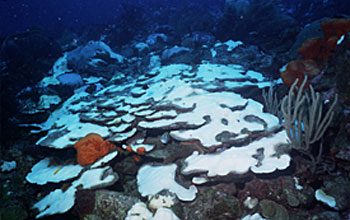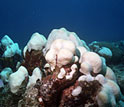News Release 09-168
Global Warming Causes Outbreak of Rare Algae in Caribbean Corals
Scientists take advantage of 'experiment of nature' to discover new insights into coral bleaching

This image was taken in October, 2005, during a coral-bleaching event in the Caribbean.
September 9, 2009
This material is available primarily for archival purposes. Telephone numbers or other contact information may be out of date; please see current contact information at media contacts.
A rare opportunity has allowed a team of scientists to evaluate corals--and the essential, photosynthetic algae that live inside their cells--before, during, and after a period in 2005 when global warming caused sea-surface temperatures in the Caribbean to rise.
The team, led by Penn State biologist Todd LaJeunesse, found that a rare species of algae that's tolerant of stressful environmental conditions proliferated in corals at a time when more sensitive algae that usually dwell within the corals were being expelled.
The results will be published in the online version of the journal Proceedings of the Royal Society B on September 9, 2009.
Certain species of algae have evolved over millions of years to live in symbiotic relationships with species of corals. These photosynthetic algae provide the corals with nutrients and energy, while the corals provide the algae with a place to live.
"There is a fine balance between giving and taking in these symbiotic relationships," said LaJeunesse.
Symbiodinium trenchi is normally a rare species of algae in the Caribbean, according to LaJeunesse. "Because the species is apparently tolerant of high or fluctuating temperatures, it was able to take advantage of a 2005 warming event and become more prolific."
Symbiodinium trenchi appears to have saved certain colonies of coral from the damaging effects of unusually warm water.
"As ocean temperatures rise as a result of global warming, we can expect this species to become more common and persistent," said LaJeunesse. "However, since it is not normally associated with corals in the Caribbean, we don't know if its increased presence will benefit or harm corals in the long term."
If Symbiodinium trenchi takes from the corals more than it gives back, over time the corals' health will decline.
"'Experiments of nature' provide unique opportunities to discover important new insights," said Michael Mishkind, program director in the National Science Foundation (NSF)'s Division of Integrative Organismal Systems, which funded the research.
"These scientists took advantage of just such an event--with the unexpected discovery that an alternate algal species was waiting in the wings. Whether this 'understudy' helps or hinders its host remains to be determined."
In 2005, sea surface temperatures in the Caribbean rose by up to two degrees Celsius above normal for a period of three to four months, high enough and long enough to severely stress corals.
The process of damaged or dying algae being expelled from the cells of corals is known as bleaching because it leaves behind bone-white coral skeletons that soon will die without their symbiotic partners.
During the summer of 2005, prior to the bleaching event, LaJeunesse and his colleagues collected samples of coral and algae from two locations near Barbados in the Caribbean.
By late November, water temperatures had peaked and many corals were bleached.
The team collected samples of coral and algae during the bleaching event and again two years after ocean temperatures returned to normal. In the laboratory, they sequenced the organisms' DNA to identify the species.
"During the bleaching event, we found that Symbiodinium trenchi, which is rarely found in the Caribbean, had increased in frequency by 50 percent or more in coral species that are most sensitive to warm water," said LaJeunesse.
"We also saw this species in corals where it had never been before. Two years later, we found that the abundance and occurrence of Symbiodinium trenchi had diminished significantly. Today the symbioses have mostly recovered to their normal state, and the corals have been repopulated by their typical algal symbionts."
Although Symbiodinium trenchi saved some corals from dying in 2005, LaJeunesse is concerned that the species might not be good for the corals if warming trends continue and Symbiodinium trenchi becomes more common.
"Because Symbiodinium trenchi does not appear to have successfully co-evolved with Caribbean coral species, it may not provide the corals with adequate nutrition," he said.
LaJeunesse plans to further investigate the relationship between Symbiodinium trenchi and Caribbean coral species.
"We're interested in looking at how it behaves in other regions of the world where it's naturally common," he said.
The research also was supported by Florida International University, Penn State University, and the University of the West Indies.
-NSF-
-
The white corals pictured have lost their symbiotic algae and appear "bleached."
Credit and Larger Version
Media Contacts
Cheryl Dybas, NSF, (703) 292-7734, email: cdybas@nsf.gov
Barbara Kennedy, Penn State, (814) 863-4682, email: science@psu.edu
The U.S. National Science Foundation propels the nation forward by advancing fundamental research in all fields of science and engineering. NSF supports research and people by providing facilities, instruments and funding to support their ingenuity and sustain the U.S. as a global leader in research and innovation. With a fiscal year 2023 budget of $9.5 billion, NSF funds reach all 50 states through grants to nearly 2,000 colleges, universities and institutions. Each year, NSF receives more than 40,000 competitive proposals and makes about 11,000 new awards. Those awards include support for cooperative research with industry, Arctic and Antarctic research and operations, and U.S. participation in international scientific efforts.
Connect with us online
NSF website: nsf.gov
NSF News: nsf.gov/news
For News Media: nsf.gov/news/newsroom
Statistics: nsf.gov/statistics/
Awards database: nsf.gov/awardsearch/
Follow us on social
Twitter: twitter.com/NSF
Facebook: facebook.com/US.NSF
Instagram: instagram.com/nsfgov



